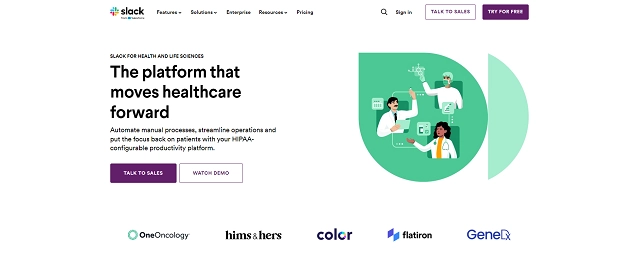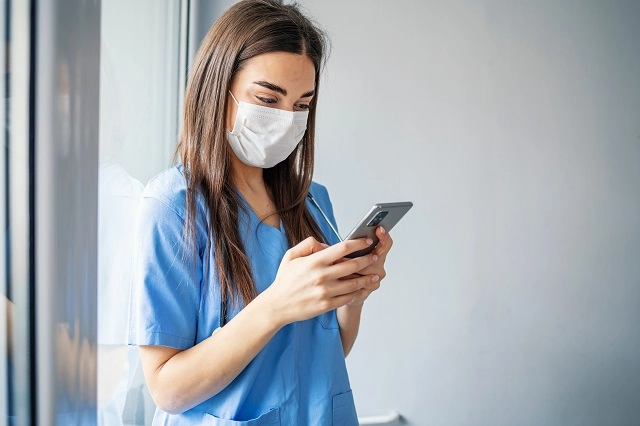Fortinet Acquires Next DLP Strengthens its Top-Tier Unified SASE Solution
Read the release
Millions of users around the world rely on instant messaging platform Slack to stay in touch. Touted as a lifeline during the pandemic, Slack isn’t just a popular solution for keeping employees connected while working both in-office and remotely, but also a convenient, mobile-friendly platform that many healthcare providers use to stay in touch.
But is Slack actually HIPAA compliant? Fortunately, it is, but with many restrictions. In this guide, we’ll explain what you need to do to configure a HIPAA-compliant Slack solution and offer tips for finding the best collaborative messaging tool for your practice.
In this article:
 |
Practices can configure Slack to meet stringent HIPAA standards, albeit with several caveats. Follow these guidelines from Slack to use its platform in a compliant way.
Slack's HIPAA-compliant features are only available through the Enterprise Grid plan. This plan includes features such as data encryption at rest and in transit, customer message retention for creating an audit trail, and data loss prevention integration.
Slack Enterprise Grid also generates detailed access logs and allows administrators to remotely terminate connections and sign users out from all connected devices. The platform is compliant with NIST standards, SOC2, and SOC3.
However, it's important to note that Slack is not HIPAA compliant by default. To achieve HIPAA compliance, healthcare organizations must obtain a business associate agreement (BAA) with Slack and configure the platform correctly to protect sensitive health information and avoid potential violations and penalties.
To comply with HIPAA, healthcare providers must sign a Business Associate Agreement with Slack. By signing a BAA, Slack agrees to protect PHI to the same degree as a healthcare provider, effectively becoming a business associate. This agreement requires Slack to protect sensitive health information in transmission, uploading, or everyday messaging, which can be a valuable way to mitigate risk.
Keep in mind that this BAA is only with Slack. If you use a third-party app through the Slack App Directory, you may need to sign a separate BAA with that provider. You’ll need a separate BAA for each provider if you use multiple apps.
Many HIPAA-compliant chat tools allow providers to chat with each other and patients, but that isn’t the case with Slack. It's important to note that HIPAA-compliant Slack use is restricted only to internal communications among employees. This means you’ll still need a separate solution to communicate directly with patients, plan members, or their families.
You can only share PHI in Slack through messages and files. Other Slack features can’t securely process PHI, emphasizing the platform's role in communication rather than comprehensive data management. Slack also isn’t intended for storing health records, so you shouldn’t use it as an electronic health record (EHR) system.
Slack will sign a BAA, but your organization is still required to use the platform in a manner that's compliant with regulations. They recommend you set up discovery APIs to monitor employees’ use of Slack and keep your data secure.
 |
Slack is a popular tool that allows healthcare teams to stay in touch with each other, but it doesn’t support patient-facing communication. That can work for some practices, especially with large support teams. However, this setup requires separate solutions for internal and external communications, which can be confusing.
If you’re looking for an alternative to Slack, consider chat tools with these features to balance convenience and compliance. These tools offer a wider range of communication options, including patient-facing communication, while still maintaining HIPAA compliance.
Secure communication begins with end-to-end encryption, ensuring only the sender and recipient can read the message. This prevents unauthorized access during transmission, safeguarding sensitive data against interception.
Even though chat tools are primarily for communication, any data stored (even temporarily) must be protected. Secure data storage with encrypted databases ensures that stored messages and files are safeguarded against unauthorized access.
Robust access controls and strong authentication methods (like two-factor authentication) are critical. They ensure that only authorized personnel can access the platform and the information it contains, reducing the risk of data breaches.
A HIPAA-compliant chat tool must provide detailed audit trails that log all user activity within the platform. This feature is vital for monitoring access to and modifications of protected health information (PHI), helping you spot potential unauthorized access and streamline compliance reporting.
 |
Slack allows providers to use its platform for internal communications but acknowledges that the platform is not perfect. Slack recommends integrating a data loss prevention (DLP) provider to fortify your security framework and protect PHI.
That’s where the Reveal Platform by Next comes in. Our DLP platform manages insider risks, identifies unmanaged endpoints, and uses machine learning to detect anomalies. Built in the cloud, Reveal instantly identifies risks and enforces policies to keep you safe and compliant. See Reveal in action: Schedule a demo now.
No, Slack doesn’t support direct patient communication. Slack is only approved for internal healthcare team communications. For patient communication, providers must use platforms specifically designed for patient engagement.
Slack uses multiple layers of security to protect data, including physical, administrative, and technical safeguards. This includes data encryption at rest and in transit, regular security audits, and compliance certifications. However, healthcare organizations should implement additional security measures, such as DLP solutions.
It’s important to note that Slack isn’t an EHR and forbids using the platform as an EHR. While Slack can integrate with various applications and software systems, you need to handle EHR integrations carefully to stay compliant. Ensure that any EHR integrated with Slack also complies with HIPAA regulations and signs a BAA.

Blog

Blog

Blog

Blog

Resources

Resources

Resources

Resources

